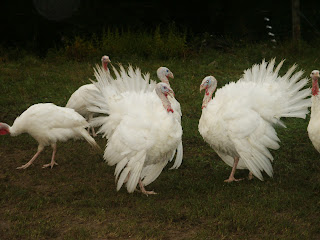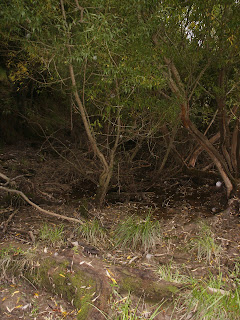6 chickens clucking
5 cattle mooing
4 piglets troughing
3 boys a-playing
2 parents nagging
And a lovely dog.
There’s a song in there somewhere. And a mental note to stop acquiring more animals.
We couldn’t resist checking out 2 Friesian X Texan Longhorn calves. 6 months old, recently weaned, with beautiful markings. They’d been raised by their mum until the week before. I’d decided that our next cattle would have spent their calf-hood with their mum rather than the (albeit cheaper) week-old boy calves which are the unwanted by-product of the dairy industry. I’d read it’s really distressing for both mother and newborn to separate them at this stage. Herein lies the dilemma – how much am I applying human values to cattle? Or am I just subconsciously supporting breastfeeding for cows? I can offer them a happy life even if they have to leave their mothers – or can I? What do I know about cattle-care anyway??
Blah blah blah.
So along came Woody and Butch. We were advised to put them in with the other cattle straight away. ‘Strangely’ hassled them, so Woody jumped the gate and 2 fences to join our neighbour’s herd across the river for most of the day. Butch kept calling him back, and eventually Woody was duly retrieved by Peter and the boys. Since then he’s managed to stay on the property and seems to consider himself at home with the others. It’s such a pleasure to see them all calmly munching and milling around the paddocks. With a lesson learned in herd-mentality.
The other new residents are the 5 Rhode Island Red hens. They’re accompanied by Robert the Rooster (aka ‘Bob’). They seem quite contented in their new accommodation, and will be released to free-range in a few days once they’re familiar with ‘home’. They’re all about 12 weeks old, so we’re not expecting eggs for a couple of months, or maybe longer as the shorter winter days are soon on their way. Bob’s particularly attractive (for poultry) and seems to be proudly in charge of his harem. Rumour has it that rooster ‘Rhodies’ can be quite aggressive. The advice is to act submissive if he tries to assert himself above you. If you retaliate, he’ll up the stakes and get more aggressive. Whereas if he believes he’s top of the pecking order, you won’t be a threat to his ‘girls’. I have mixed feelings regarding chicken psychology in general and rooster obedience in particular, but maybe it’s worth a try. Just exactly how are you submissive to a rooster??
Meanwhile the pigs grow and grow and grow and grow. Might be because they eat a lot. They have warm porridge and manufactured pig nuts in the morning, and sprouted grains and scraps/fruit later in the day. And they have turned over most of the ground so have added roots, bugs and a fair measure of mud to their diets. They are endlessly entertaining, though it’s becoming more of a mission to get inside the pen. They’re so keen to eat they knock whatever you’re carrying – soon no doubt that will include knocking me over too. I have to be one step ahead of them and plan distractions. I end up covered in mud every time.
I have a 5 bucket system going on for the grain-sprouting. I use a mix of barley, oats, wheat, maize and peas. On day 1 they are soaked in water with a pinch of salt for 12 hours. Thereafter they are drained and then rinsed twice a day. By day 3 the sprouts are coming through, and at day 5 they’re a tangled mass of roots and shoots. I’ve read that this way they are more nutritious and easier to digest. And the pigs love them.
The turkeys have definitely declared themselves as 3 boys and 4 girls. The boys must be reaching puberty because they’ve started strutting around, feathers fluffed, gobbling loudly and picking fights with each other. We’re not sure whether it’s wise to keep 3 males (toms). We would like to hear the pitter-patter of tiny turkey feet at some stage, so maybe a decision has to be made soon-ish. Hmmm, I’ll work on that one.
The worms are amazingly still there and more plentiful. They may be rewarded for staying alive against the odds with new, improved premises. It seems, happily, that they enjoy a combination of overfeeding followed by neglect. Better not gloat too soon though – winter’s on its way. The bees are still buzzing and there’s honey, but alas no brood. Maybe something happened to the queen? Apparently it’s not a good time of year to re-queen, so I’m waiting to see what happens. Optimistically a new queen will appear, and pessimistically I’ll lose this colony and have to get another in spring. I’m not sure what I can learn from it though, as it’s a bit of mystery.
The veg garden is still pretty much over-run with weeds, though it remains productive. It’s feeding us with carrots, onions, tomatoes, leeks and some greens. And it’s feeding the animals – corn, marrow, pumpkin, gourd and greens-going-to seed. I put the veg in a boil-up for the pigs, adding windfall apples. Looks disgusting, but apparently tastes great. I just chuck the greens over the fence for the cows – they lurk nearby, gazing with their big, brown eyes, when I’m working in the veg garden.
Peter’s done a lot of work getting the electric fence so it zaps effectively. A storm brought down a tree which pretty much earthed it. There are other places where weed growth is affecting it, and our electric lawn edge trimmer just wasn’t doing the job. A noisy, petrol-driven brush-cutter with 3 blades is much more effective, and a real man-tool. Fingers crossed it doesn’t go the usual route of most of our power tools too soon.
The advice we got about the wetland essentially involves getting rid of the rampant willows. They are non-native ‘crack willows’ which mean they drop branches off or keel over, then re-grow from several new shoots. Their roots have made a mesh on the ground, and their canopy is very dense – blocking out the light. We’ve stopped the area being grazed, so that if there are any native seeds they have a chance, and we’re in the process of drilling the willows and injecting them with neat round-up (as advised). They’ll need to be cut down in about 3 months after this treatment. Not exactly an organic approach, but the alternative will require decades before any impact is made. We can apply for a protective covenant for the wetland area, so that future occupants of the land have to maintain it. Probably we’ll do that when it starts to look a bit more like native wetland. Native plants, grown from local seed, can be bought cheaply, and I’m thinking of approaching the local school to see of any kids want a planting project. There's already optimisim that it won't be too difficult to promote wildlife - this native forest weta was found (unwisely) trying to get into Lucas' school bag (left outside):
In the meantime the rest of our lives roll on. I'm really hoping that at some point I can reduce my working hours to spend more time on the farm (the term 'farm' has surreptitiously pushed out 'lifestlye bock', which I'm not keen on, and 'smallholding' which I am keen on but is just too pommy). I have no idea how that could possibly happen, so am holding onto the thought that things sometimes just work out. It's a good feeling to be providing our boys with the chance to experience farm-life before they fly the nest. There are definitely times when they think we're nuts, but they do succumb to a kind of infectiousness that it's good living. And there has yet to be a visiting friend who fails to return home proudly muddy and bruised.








